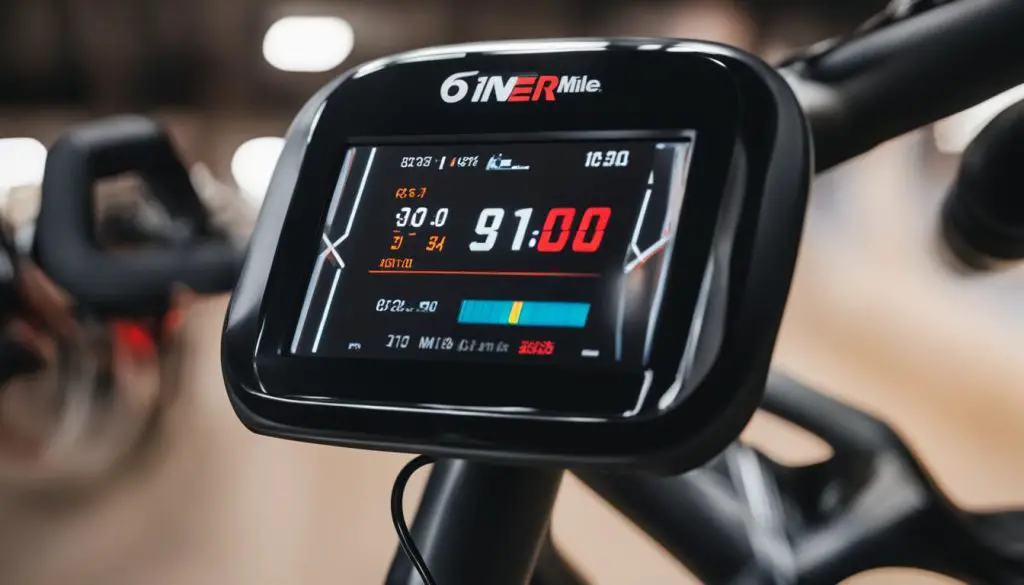Note that this post contains affiliate links and we may earn a small commission at no extra cost to you if you buy something.
When it comes to setting mileage goals on a stationary bike, it’s important to have a clear understanding of what constitutes a good mile time. Whether you’re a beginner or an advanced cyclist, having a benchmark to strive for can help you track your progress and stay motivated.
So, what is considered a good mile time on a stationary bike? The answer depends on various factors, including your fitness level, goals, and overall cycling experience. Let’s explore some guidelines to help you determine an ideal mile time on a stationary bike.
Key Takeaways:
- A good mile time on a stationary bike depends on factors like fitness level, goals, and experience.
- For beginners, aiming for 10-15 miles per week is a good starting point.
- Intermediate cyclists can aim for 100-150 miles per week to continue building stamina.
- Advanced cyclists should strive for 300-500 miles per week to improve strength, speed, and endurance.
- Remember to have fun with your goals and adjust them as needed to stay motivated on your cycling journey.
Factors Affecting Mile Time on a Stationary Bike
When it comes to completing a mile on a stationary bike, several factors can influence your time. It’s essential to understand these factors to improve your performance and achieve your fitness goals. Let’s explore the key elements that play a role in mile time on a stationary bike.
Fitness Level
Your fitness level is a crucial factor that affects your mile time on a stationary bike. More experienced and fit cyclists generally ride at a faster pace, covering more distance in less time. As you build strength, endurance, and cardiovascular fitness, your mile time will naturally improve.
Bike Type
The type of bike you use can also impact your mile time. Different bike types have varying efficiencies and features that affect speed and performance. Road bikes, with their narrow and smooth tires, are typically the fastest option for stationary cycling. Their design allows for faster and smoother rides, resulting in shorter mile times. However, other bike types such as hybrid or mountain bikes may provide a more comfortable and versatile workout experience.
Terrain
The terrain you simulate on your stationary bike can influence your mile time. Flat roads allow for a more straightforward ride, allowing you to maintain a faster pace. On the other hand, simulated hills or inclines can add resistance to your workout, potentially slowing down your mile time. When setting your mile time goals, consider the terrain you’ll be riding on to adjust your expectations accordingly.
Weather
Although you’re riding indoors on a stationary bike, weather conditions can still impact your overall mile time. For example, wind resistance can affect your speed, making it more challenging to maintain a fast pace. Similarly, extreme temperatures can impact your performance, as your body may have to work harder to regulate its temperature. Keep in mind that these weather-related factors may not be as significant indoors, but they can still play a role in your mile time.
Air Resistance
The way your body interacts with the air resistance while cycling can affect your mile time. Factors such as body position and clothing choice can influence the drag you experience while riding. Optimal body positioning, such as maintaining an aerodynamic posture, can help reduce air resistance and potentially improve your speed. Likewise, choosing clothing that minimizes drag, such as form-fitting and streamlined attire, can contribute to faster mile times.
Understanding the factors that impact your mile time on a stationary bike is essential for setting realistic goals and tracking your progress. By considering your fitness level, bike type, terrain, weather, and air resistance, you can work towards improving your performance and achieving your desired mile time.
Improving Mile Time on a Stationary Bike
If you’re looking to improve your mile time on a stationary bike, there are several strategies you can incorporate into your training routine. One of the most effective ways is through regular fitness training. By engaging in cardiovascular exercises and strength training, you can increase your overall stamina and muscular endurance. This will not only help you ride faster but also enhance your overall performance.
Another crucial aspect is maintaining your bike’s condition. Perform regular maintenance tasks, such as checking tire pressure and ensuring all moving parts are well-lubricated. By keeping your bike in optimal shape, you can maximize its performance and reduce any potential drag that may slow you down.
Proper technique is also essential to improve your mile time. Focus on maintaining a steady cadence, which refers to the number of pedal revolutions per minute. Aim for a moderate and consistent pace, allowing you to sustain your energy throughout the ride. Additionally, pay attention to your body position, ensuring it is aerodynamic and optimized for speed.
Furthermore, your clothing choice can have an impact on your mile time. Opt for form-fitting and lightweight attire that minimizes air resistance. Loose or baggy clothing can create drag and hinder your performance. Additionally, always ride in optimal conditions, avoiding strong headwinds or extreme weather conditions that may impede your progress.
Andrew Hansen is a seasoned cyclist and fitness enthusiast dedicated to promoting a healthier lifestyle through stationary exercise biking. With over two decades of experience in the cycling world, Andrew has covered countless trails globally, bringing a wealth of knowledge to his role as the founder and primary writer at Life Fitness Bike.
Andrew’s passion lies in stationary exercise biking, and he is committed to providing comprehensive resources for cycling enthusiasts of all levels. His articles are not only informative but also reflect the joy and fitness benefits that stationary cycling brings. As the driving force behind Life Fitness Bike, Andrew wears many hats—founder, writer, and expert in the field—making him a valuable guide for individuals seeking to make the most of their stationary exercise cycling experience.


